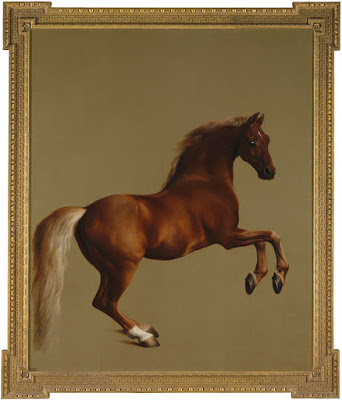WHISTLEJACKET
BY GEORGE STUBBS
this is one of those paintings that, on its own, is worth the visit to the National Gallery. Its size, its ambition, its audacity all embrace you. In my career as a film-maker I have often had reason to include images of kings & emperors on their trusted steeds. Julius Caesar, Napoleon, Alexander, Ulysses S. Grant, Zhukov (on his white steed in Red Square), and plenty more. But it’s rare that the horse itself is the subject. No bridle in sight, no stirrups, no whip. This is a horse bursting with life and freedom. There is no background but you can add that in yourself. For me, it is the gorgeous Sussex countryside where I live that fills in the blanks but it could be anywhere. Some have argued that Stubbs was supposed to have filled in both background and rider but I simply don’t believe it. I am sure the painting is just as he wanted it.
18th century Britain was passionate about horses – and horse-racing – and this was a race-winning horse (notably the 2000 guineas at York in 1759) that didn’t need a monarch on its back to tell a great story. We know that Whistlejacket – strange name, possibly to do with the colour of the coat matching a drink of that colour made of brandy – was foaled in 1749 and was owned by the Marquess of Rockingham, who was twice Prime Minister. The horse had been retired by the time Stubbs was commissioned to paint him in 1762 but he must have been still much loved and admired. And why not – he is magnificent, flaring, all-powerful.
Stubbs was a master of painting horses – and he certainly sought and caught the individuality of this stallion. It is no accident that he so wonderfully captures the tension and strain in the musculature – Stubbs had gone so far as to dissect horses to gain greater insight into their inner workings. Stubbs was in his late 30s when he painted this. Born in Liverpool, son of a leather worker, largely self-taught as an artist, he ultimately specialized in anatomical paintings especially of the horse. No doubt the bones and skins from his father’s tannery were some kind of inspiration but he went much further than that. He studied anatomy to such a degree that he lectured medical students on it and even apparently, in 1756, rented a barn near Hull and, with a female assistant, Mary Spencer (his unofficial companion for 50 years), spent 18 months dissecting horses. They were delivered to him live, and he undertook the messy work of slaughtering, with the objective of learning equine anatomy through detailed personal investigation.
Stubbs published a book with drawings called The Anatomy of the Horse in 1756 and soon thereafter he received his first London commission from the artist Joshua Reynolds. One group of potential buyers who were immediately taken with Stubbs’s ‘Anatomy of the Horse’ drawings and enticed by the idea of a portrait or two of their own much-prized horses were wealthy young aristocrats with country estates. And within another few years, as mentioned, the twice-Prime Minister himself commissioned Stubbs for Whistlejacket. It is a striking picture, well worth a few minutes of your time when you are next passing the National Gallery. And, as an afterthought, if you live in or are visiting Ireland, I’d also recommend Stubbs’ painting Hambletonian which hangs in the National Trust property of Mount Stewart in County Down. We filmed it when we made our film Tim Marlow on Stubbs and the Horse in 2005 and it is another gorgeous work.
* * *



